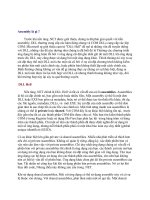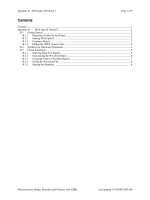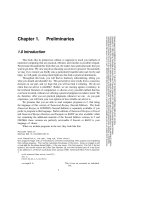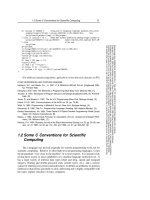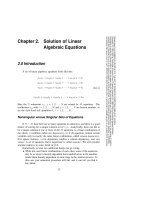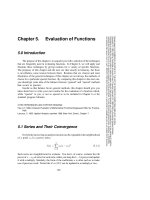Tài liệu Eigensystems part 1 docx
Bạn đang xem bản rút gọn của tài liệu. Xem và tải ngay bản đầy đủ của tài liệu tại đây (99.71 KB, 8 trang )
Sample page from NUMERICAL RECIPES IN C: THE ART OF SCIENTIFIC COMPUTING (ISBN 0-521-43108-5)
Copyright (C) 1988-1992 by Cambridge University Press.Programs Copyright (C) 1988-1992 by Numerical Recipes Software.
Permission is granted for internet users to make one paper copy for their own personal use. Further reproduction, or any copying of machine-
readable files (including this one) to any servercomputer, is strictly prohibited. To order Numerical Recipes books,diskettes, or CDROMs
visit website or call 1-800-872-7423 (North America only),or send email to (outside North America).
Chapter 11. Eigensystems
11.0 Introduction
An N × N matrix A is said to have an eigenvector x and corresponding
eigenvalue λ if
A · x = λx (11.0.1)
Obviously any multiple of an eigenvector x will also be an eigenvector, but we
won’t consider such multiples as being distinct eigenvectors. (The zero vector is not
considered to be an eigenvector at all.) Evidently (11.0.1) can hold only if
det |A − λ1| =0 (11.0.2)
which, if expanded out, is an Nth degree polynomial in λ whose roots are the eigen-
values. This proves that there are always N (not necessarily distinct) eigenvalues.
Equal eigenvalues coming frommultiplerootsarecalled degenerate. Root-searching
in the characteristic equation (11.0.2) is usually a very poor computational method
for finding eigenvalues. We will learn much better ways in this chapter, as well as
efficient ways for finding corresponding eigenvectors.
The above two equations also prove that every one of the N eigenvalues has
a (not necessarily distinct) corresponding eigenvector: If λ is set to an eigenvalue,
then the matrix A − λ1 is singular, and we know that every singular matrix has at
least one nonzero vector in its nullspace (see §2.6 on singular value decomposition).
If you add τx to both sides of (11.0.1), you will easily see that the eigenvalues
of any matrix can be changed or shifted by an additive constant τ by adding to
the matrix that constant times the identity matrix. The eigenvectors are unchanged
by this shift. Shifting, as we will see, is an important part of many algorithms
for computing eigenvalues. We see also that there is no special significance to a
zero eigenvalue. Any eigenvalue can be shifted to zero, or any zero eigenvalue
can be shifted away from zero.
456
11.0 Introduction
457
Sample page from NUMERICAL RECIPES IN C: THE ART OF SCIENTIFIC COMPUTING (ISBN 0-521-43108-5)
Copyright (C) 1988-1992 by Cambridge University Press.Programs Copyright (C) 1988-1992 by Numerical Recipes Software.
Permission is granted for internet users to make one paper copy for their own personal use. Further reproduction, or any copying of machine-
readable files (including this one) to any servercomputer, is strictly prohibited. To order Numerical Recipes books,diskettes, or CDROMs
visit website or call 1-800-872-7423 (North America only),or send email to (outside North America).
Definitions and Basic Facts
A matrix is called symmetric if it is equal to its transpose,
A = A
T
or a
ij
= a
ji
(11.0.3)
It iscalledHermitianor self-adjointif itequalsthecomplex-conjugateof itstranspose
(its Hermitian conjugate, denoted by “†”)
A = A
†
or a
ij
= a
ji
*(11.0.4)
It is termed orthogonal if its transpose equals its inverse,
A
T
· A = A · A
T
= 1 (11.0.5)
and unitary if its Hermitian conjugate equals its inverse. Finally, a matrix is called
normal if it commutes with its Hermitian conjugate,
A · A
†
= A
†
· A (11.0.6)
For real matrices, Hermitian means the same as symmetric, unitary means the
same as orthogonal, and both of these distinct classes are normal.
The reason that “Hermitian” is an important concept has to do with eigenvalues.
The eigenvalues of a Hermitian matrix are all real. In particular, the eigenvalues
of a real symmetric matrix are all real. Contrariwise, the eigenvalues of a real
nonsymmetricmatrix may include real values, but may also includepairs of complex
conjugate values; and the eigenvalues of a complex matrix that is not Hermitian
will in general be complex.
The reason that “normal” is an important concept has to do with the eigen-
vectors. The eigenvectors of a normal matrix with nondegenerate (i.e., distinct)
eigenvalues are complete and orthogonal, spanning the N-dimensional vector space.
For a normal matrix with degenerate eigenvalues, we have the additional freedom of
replacing the eigenvectors corresponding to a degenerate eigenvalue by linear com-
binations of themselves. Using this freedom, we can always perform Gram-Schmidt
orthogonalization(consult any linear algebra text) and find a set of eigenvectors that
are complete and orthogonal, just as in the nondegenerate case. The matrix whose
columns are an orthonormal set of eigenvectors is evidently unitary. A special case
is that the matrix of eigenvectors of a real, symmetric matrix is orthogonal, since
the eigenvectors of that matrix are all real.
When a matrix is not normal, as typified by any random, nonsymmetric, real
matrix, then in general we cannot find any orthonormal set of eigenvectors, nor even
any pairs of eigenvectors that are orthogonal (except perhaps by rare chance). While
the N non-orthonormal eigenvectors will “usually” span the N-dimensional vector
space, they do not always do so; that is, the eigenvectors are not always complete.
Such a matrix is said to be defective.
458
Chapter 11. Eigensystems
Sample page from NUMERICAL RECIPES IN C: THE ART OF SCIENTIFIC COMPUTING (ISBN 0-521-43108-5)
Copyright (C) 1988-1992 by Cambridge University Press.Programs Copyright (C) 1988-1992 by Numerical Recipes Software.
Permission is granted for internet users to make one paper copy for their own personal use. Further reproduction, or any copying of machine-
readable files (including this one) to any servercomputer, is strictly prohibited. To order Numerical Recipes books,diskettes, or CDROMs
visit website or call 1-800-872-7423 (North America only),or send email to (outside North America).
Left and Right Eigenvectors
While the eigenvectors of a non-normal matrix are not particularly orthogonal
among themselves, they do have an orthogonality relation with a different set of
vectors, which we must now define. Up to now our eigenvectors have been column
vectors that are multiplied to the right of a matrix A, as in (11.0.1). These, more
explicitly, are termed right eigenvectors. We could also, however, try to find row
vectors, which multiply A to the left and satisfy
x · A = λx (11.0.7)
These are called left eigenvectors. By taking the transpose of equation (11.0.7), we
see that every left eigenvector is the transpose of a right eigenvector of the transpose
of A. Now by comparing to (11.0.2), and using the fact that the determinant of a
matrix equals the determinant of its transpose, we also see that the left and right
eigenvalues of A are identical.
If the matrix A is symmetric, then the left and right eigenvectors are just
transposes of each other, that is, have the same numerical values as components.
Likewise, if the matrix is self-adjoint, the left and right eigenvectors are Hermitian
conjugates of each other. For the general nonnormal case, however, we have the
following calculation: Let X
R
be the matrix formed by columns from the right
eigenvectors, and X
L
be the matrix formed by rows from the left eigenvectors. Then
(11.0.1) and (11.0.7) can be rewritten as
A · X
R
= X
R
· diag(λ
1
...λ
N
) X
L
·A =diag(λ
1
...λ
N
)·X
L
(11.0.8)
Multiplying the first of these equations on the left by X
L
, the second on the right
by X
R
, and subtracting the two, gives
(X
L
· X
R
) · diag(λ
1
...λ
N
)=diag(λ
1
...λ
N
)·(X
L
·X
R
)(11.0.9)
This says that the matrix of dot products of the left and right eigenvectors commutes
with the diagonal matrix of eigenvalues. But the only matrices that commute with a
diagonalmatrix of distinct elements are themselves diagonal. Thus, iftheeigenvalues
are nondegenerate, each left eigenvector is orthogonalto all right eigenvectors except
its corresponding one, and vice versa. By choice of normalization, the dot products
of corresponding left and right eigenvectors can always be made unity for any matrix
with nondegenerate eigenvalues.
If some eigenvalues are degenerate, then either the left or the right eigenvec-
tors corresponding to a degenerate eigenvalue must be linearly combined among
themselves to achieve orthogonality with the right or left ones, respectively. This
can always be done by a procedure akin to Gram-Schmidt orthogonalization. The
normalizationcan then be adjusted to giveunityfor the nonzero dotproductsbetween
correspondingleft and righteigenvectors. If the dot productof correspondingleft and
right eigenvectors is zero at this stage, then you have a case where the eigenvectors
are incomplete! Note that incomplete eigenvectors can occur only where there are
degenerate eigenvalues, but do not always occur in such cases (in fact, never occur
for the class of “normal” matrices). See
[1]
for a clear discussion.
11.0 Introduction
459
Sample page from NUMERICAL RECIPES IN C: THE ART OF SCIENTIFIC COMPUTING (ISBN 0-521-43108-5)
Copyright (C) 1988-1992 by Cambridge University Press.Programs Copyright (C) 1988-1992 by Numerical Recipes Software.
Permission is granted for internet users to make one paper copy for their own personal use. Further reproduction, or any copying of machine-
readable files (including this one) to any servercomputer, is strictly prohibited. To order Numerical Recipes books,diskettes, or CDROMs
visit website or call 1-800-872-7423 (North America only),or send email to (outside North America).
In both the degenerate and nondegenerate cases, the final normalization to
unity of all nonzero dot products produces the result: The matrix whose rows
are left eigenvectors is the inverse matrix of the matrix whose columns are right
eigenvectors, if the inverse exists.
Diagonalization of a Matrix
Multiplying the first equation in (11.0.8) by X
L
, and using the fact that X
L
and X
R
are matrix inverses, we get
X
−1
R
· A · X
R
= diag(λ
1
...λ
N
)(11.0.10)
This is a particular case of a similarity transform of the matrix A,
A → Z
−1
· A · Z (11.0.11)
for some transformation matrix Z. Similarity transformations play a crucial role
in the computation of eigenvalues, because they leave the eigenvalues of a matrix
unchanged. This is easily seen from
det
Z
−1
· A · Z − λ1
= det
Z
−1
· (A − λ1) · Z
= det |Z| det |A − λ1| det
Z
−1
= det |A − λ1|
(11.0.12)
Equation (11.0.10) showsthat anymatrixwithcompleteeigenvectors(which includes
all normal matrices and “most” random nonnormal ones) can be diagonalized by a
similarity transformation, that the columns of the transformation matrix that effects
the diagonalization are the right eigenvectors, and that the rows of its inverse are
the left eigenvectors.
For real, symmetric matrices, the eigenvectors are real and orthonormal, so the
transformation matrix is orthogonal. The similarity transformation is then also an
orthogonal transformation of the form
A → Z
T
· A · Z (11.0.13)
Whilereal nonsymmetricmatrices can bediagonalizedin theirusual case ofcomplete
eigenvectors, the transformation matrix is not necessarily real. It turns out, however,
that a real similarity transformation can “almost” do the job. It can reduce the
matrix down to a form with little two-by-two blocks along the diagonal, all other
elements zero. Each two-by-two block corresponds to a complex-conjugate pair
of complex eigenvalues. We will see this idea exploited in some routines given
later in the chapter.
The “grand strategy” of virtually all modern eigensystem routines is to nudge
the matrix A towards diagonal form by a sequence of similarity transformations,
A → P
−1
1
· A · P
1
→ P
−1
2
· P
−1
1
· A · P
1
· P
2
→ P
−1
3
· P
−1
2
· P
−1
1
· A · P
1
· P
2
· P
3
→ etc.
(11.0.14)
460
Chapter 11. Eigensystems
Sample page from NUMERICAL RECIPES IN C: THE ART OF SCIENTIFIC COMPUTING (ISBN 0-521-43108-5)
Copyright (C) 1988-1992 by Cambridge University Press.Programs Copyright (C) 1988-1992 by Numerical Recipes Software.
Permission is granted for internet users to make one paper copy for their own personal use. Further reproduction, or any copying of machine-
readable files (including this one) to any servercomputer, is strictly prohibited. To order Numerical Recipes books,diskettes, or CDROMs
visit website or call 1-800-872-7423 (North America only),or send email to (outside North America).
If we get all the way to diagonal form, then the eigenvectors are the columns of
the accumulated transformation
X
R
= P
1
· P
2
· P
3
· ... (11.0.15)
Sometimes we do not want to go all the way to diagonal form. For example, if
we are interested only in eigenvalues, not eigenvectors, it is enough to transform
the matrix A to be triangular, with all elements below (or above) the diagonal zero.
In this case the diagonal elements are already the eigenvalues, as you can see by
mentally evaluating (11.0.2) using expansion by minors.
There are two rather different sets of techniques for implementing the grand
strategy (11.0.14). It turns out that they work rather well in combination, so most
modern eigensystem routinesuse both. The first set of techniques constructsindivid-
ual P
i
’s as explicit “atomic” transformations designed to perform specific tasks, for
example zeroing a particular off-diagonal element (Jacobi transformation, §11.1), or
a whole particular row or column (Householder transformation, §11.2; elimination
method, §11.5). In general, a finite sequence of these simple transformations cannot
completely diagonalize a matrix. There are then two choices: either use the finite
sequence of transformations to go most of the way (e.g., to some special form like
tridiagonalor Hessenberg,see§11.2 and §11.5 below) and followup with the second
set of techniques about to be mentioned; or else iterate the finite sequence of simple
transformations over and over until the deviation of the matrix from diagonal is
negligibly small. This latter approach is conceptually simplest, so we will discuss
it in the next section; however, for N greater than ∼ 10, it is computationally
inefficient by a roughly constant factor ∼ 5.
The second set of techniques, called factorization methods, is more subtle.
Suppose that the matrix A can be factored into a left factor F
L
and a right factor
F
R
.Then
A=F
L
·F
R
or equivalently F
−1
L
· A = F
R
(11.0.16)
If we now multiply back together the factors in the reverse order, and use the second
equation in (11.0.16) we get
F
R
· F
L
= F
−1
L
· A · F
L
(11.0.17)
which we recognize as having effected a similarity transformation on A with the
transformation matrix being F
L
!In§11.3 and §11.6 we will discuss the QR method
which exploits this idea.
Factorization methods also do not converge exactly in a finite number of
transformations. But the better ones do converge rapidly and reliably, and, when
following an appropriate initial reduction by simple similarity transformations, they
are the methods of choice.



